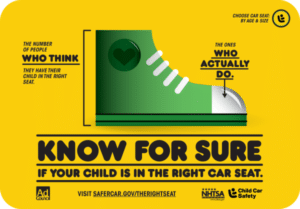Have you been meaning to have your child safety seat inspected by a certified technician?
The Wilmington Police Department offers weekly safety seat installs at the station without an appointment!
The Wilmington Police Department will be conducting Child Safety Seat Inspections and Installations at the Public Safety Building on Wednesdays between 10:00 a.m. and 2:00 p.m. No appointments are necessary, however, it is strongly encouraged that you call ahead to make sure a technician is available. Our business line is 978-658-5071.
- If you would like us to install a new seat, familiarize yourself with the seat and if possible, attempt to install it yourself prior to the inspection.
- Bring the owner’s manuals for both the child seat and your vehicle to the inspection.
- Remove trash and debris from your vehicle.
- If possible, bring the child who will be using the seat. This will allow our technicians to ensure the seat is adjusted properly for the child.
The importance of properly fitted Child Safety Seats is self evident, as a minor crash or even a sudden stop can seriously injure a child who is not riding in the correct type of car seat. You can reduce the risk by buckling your child into a properly fitted safety seat every time they ride in the car.
Best Practices for Car Seat Safety
- The best car seat is not always the most expensive one — it’s the one that best fits a child’s weight, size, and age, as well as your vehicle. Different types of car seats are required for children of different ages.
- Birth through Age 2: Rear-facing child safety seat. For the best possible protection, infants and children should be kept in a rear-facing child safety seat, in the back seat buckled with the seat’s harness, until they reach the upper weight or height limits of their particular seat. The weight and height limits on rear-facing child safety seats can accommodate most children through age 2, check the seat’s owner’s manual for details.
- Between Ages 2-4/Until 40 lbs – Forward-facing child safety seat. When children outgrow their rear-facing seats (the weight and height limits on rear-facing car seats can accommodate most children through age 2) they should ride in forward-facing child safety seats, in the back seat buckled with the seat’s harness, until they reach the upper weight or height limit of their particular seat (usually around age 4 and 40 pounds; many newer seats have higher weight limits-check the seat’s owner’s manual for details).
- Between Ages 4-8 OR Until 4’9″ Tall – Booster seat. Once children outgrow their forward-facing seats (by reaching the upper height and weight limits of their seat), they should ride in belt positioning booster seats. Remember to keep children in the back seat for the best possible protection. The Massachusetts Child Passenger Safety Law requires children to ride as passengers motor vehicles in a federally approved child passenger restraint that is properly fastened and secured until they are 8 years old OR over 57 inches tall.
- Children 12 and younger should never sit in the front seat. The safest seating position is in the back seat, away from air bags if possible.
- If children 13 years of age or older ride in the front seat, they should position their seat as far back as possible from the air bag.
- Always wear your lap and shoulder belt when driving — it protects you in the case of a crash and it sets a good example for children.
If you have any questions, please call us at 978-658-5071.
